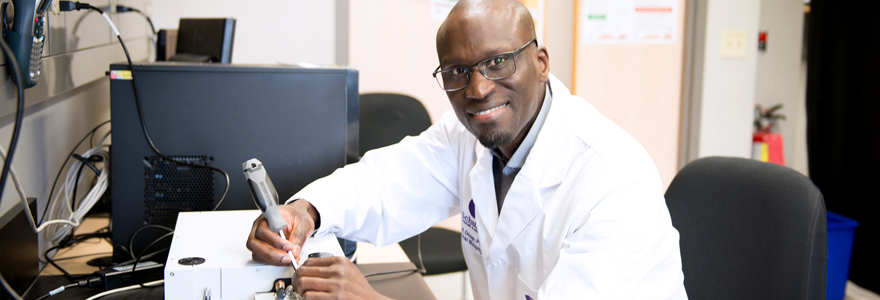Building machines for better health
By Emily Leighton, MA’13
Turn on your cellphone’s flashlight and hold your finger over it. What do you see?
As the light passes through your finger, it should turn red.
Because red has the highest wavelength on the visible electromagnetic spectrum, it is weakly absorbed by tissue and therefore transmitted deeper into your finger. By comparison, wavelengths associated with blue and green fall in a lower range and are more strongly absorbed.
Mamadou Diop,
One way to measure these biomarkers is through a method called near-infrared spectroscopy, which applies the same concept illustrated by the flashlight experiment – transmitting high wavelength light deep into tissue.
“By doing this, we can measure the concentration of blood, water, fat and other important tissue components,” Diop explained. “We then use mathematical modelling of light propagation in tissue to extract information.”
When using this clinically, an important application is measuring cerebral
“With high-risk procedures, such as heart surgery, it is important to know what is happening to the brain,” said Diop. “This non-invasive technology will help monitor blood flow and inform clinicians right away should problems arise.”
Diop is also applying this work to other areas as well, such as joint inflammation.
Born and raised in Senegal, Diop graduated from Université Cheikh Anta Diop of Dakar with an undergraduate and master’s degree. He also completed teachers college during his
The researcher moved to Canada to pursue
After adjusting to Quebec City’s famously cold winters, he journeyed westward to Ottawa, joining the National Research Council of Canada’s Institute for Microstructural Sciences for a two-year postdoctoral position.
In 2006, he landed in London for a second postdoctoral position, based at Lawson Health Research Institute with Keith St. Lawrence,
As a faculty member at Schulich Medicine & Dentistry, he says teaching and working with students is an essential part of his role. “Mentoring students is part of doing research,” he said. “We are tackling problems together as colleagues, and they are an integral part of the team.”
Diop’s lab is called the Translational Biophotonics Lab, reflecting the complex technical work he oversees, as well as the important connection to



